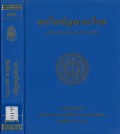
(10) พระไตรปิฎกภาษาไทย พระสุต�…
พิมพ์เฉลิมพระเกียรติ สมเด็จพระนางเจ้าสิริกิติ์ พระบรมราชินีนาถ เนื่�…
- ครั้งที่จัดทำ
- 1
- ISBN/ISSN
- 9745753696
- ลักษณะวัสดุ
- -
- ชื่อชุด
- พระไตรปิฎกภาษาไทย ฉบับมหาจุฬาลงกรณราชวิทยาลัย
- เลขหมู่
- BQ 1173 T5 ม562 2539 ล.10
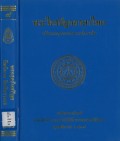
(9) พระไตรปิฎกภาษาไทย พระสุตต…
พิมพ์เฉลิมพระเกียรติ สมเด็จพระนางเจ้าสิริกิติ์ พระบรมราชินีนาถ เนื่�…
- ครั้งที่จัดทำ
- 1
- ISBN/ISSN
- 9745753696
- ลักษณะวัสดุ
- -
- ชื่อชุด
- พระไตรปิฎกภาษาไทย ฉบับมหาจุฬาลงกรณราชวิทยาลัย
- เลขหมู่
- BQ 1173 T5 ม562 2539 ล.9
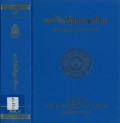
(8) พระไตรปิฎกภาษาไทย พระวินั…
พิมพ์เฉลิมพระเกียรติ สมเด็จพระนางเจ้าสิริกิติ์ พระบรมราชินีนาถ เนื่�…
- ครั้งที่จัดทำ
- 1
- ISBN/ISSN
- 9745753696
- ลักษณะวัสดุ
- -
- ชื่อชุด
- พระไตรปิฎกภาษาไทย ฉบับมหาจุฬาลงกรณราชวิทยาลัย
- เลขหมู่
- BQ 1173 T5 ม562 2539 ล.8
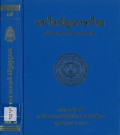
(7) พระไตรปิฎกภาษาไทย พระวินั…
พิมพ์เฉลิมพระเกียรติ สมเด็จพระนางเจ้าสิริกิติ์ พระบรมราชินีนาถ เนื่�…
- ครั้งที่จัดทำ
- 1
- ISBN/ISSN
- 9745753696
- ลักษณะวัสดุ
- -
- ชื่อชุด
- พระไตรปิฎกภาษาไทย ฉบับมหาจุฬาลงกรณราชวิทยาลัย
- เลขหมู่
- BQ 1173 T5 ม562 2539 ล.7
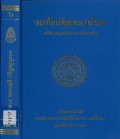
(6) พระไตรปิฎกภาษาไทย พระวินั…
พิมพ์เฉลิมพระเกียรติ สมเด็จพระนางเจ้าสิริกิติ์ พระบรมราชินีนาถ เนื่�…
- ครั้งที่จัดทำ
- 1
- ISBN/ISSN
- 9745753696
- ลักษณะวัสดุ
- -
- ชื่อชุด
- พระไตรปิฎกภาษาไทย ฉบับมหาจุฬาลงกรณราชวิทยาลัย
- เลขหมู่
- BQ 1173 T5 ม562 2539 ล.6
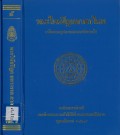
(5) พระไตรปิฎกภาษาไทย พระวินั…
พิมพ์เฉลิมพระเกียรติ สมเด็จพระนางเจ้าสิริกิติ์ พระบรมราชินีนาถ เนื่�…
- ครั้งที่จัดทำ
- 1
- ISBN/ISSN
- 9745753696
- ลักษณะวัสดุ
- -
- ชื่อชุด
- พระไตรปิฎกภาษาไทย ฉบับมหาจุฬาลงกรณราชวิทยาลัย
- เลขหมู่
- BQ 1173 T5 ม562 2539 ล.5
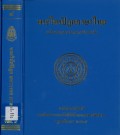
(4) พระไตรปิฎกภาษาไทย พระวินั…
พิมพ์เฉลิมพระเกียรติ สมเด็จพระนางเจ้าสิริกิติ์ พระบรมราชินีนาถ เนื่�…
- ครั้งที่จัดทำ
- 1
- ISBN/ISSN
- 9745753696
- ลักษณะวัสดุ
- -
- ชื่อชุด
- พระไตรปิฎกภาษาไทย ฉบับมหาจุฬาลงกรณราชวิทยาลัย
- เลขหมู่
- BQ 1173 T5 ม562 2539 ล.4
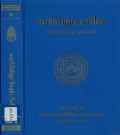
(3) พระไตรปิฎกภาษาไทย พระวินั…
พิมพ์เฉลิมพระเกียรติ สมเด็จพระนางเจ้าสิริกิติ์ พระบรมราชินีนาถ เนื่�…
- ครั้งที่จัดทำ
- 1
- ISBN/ISSN
- 9745753696
- ลักษณะวัสดุ
- -
- ชื่อชุด
- พระไตรปิฎกภาษาไทย ฉบับมหาจุฬาลงกรณราชวิทยาลัย
- เลขหมู่
- BQ 1173 T5 ม562 2539 ล.3

(2) พระไตรปิฎกภาษาไทย พระวินั…
พิมพ์เฉลิมพระเกียรติ สมเด็จพระนางเจ้าสิริกิติ์ พระบรมราชินีนาถ เนื่�…
- ครั้งที่จัดทำ
- 1
- ISBN/ISSN
- 9745753696
- ลักษณะวัสดุ
- -
- ชื่อชุด
- พระไตรปิฎกภาษาไทย ฉบับมหาจุฬาลงกรณราชวิทยาลัย
- เลขหมู่
- BQ 1173 T5 ม562 2539 ล.2
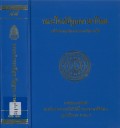
(45) พระไตรปิฎกภาษาไทย พระอภิ�…
พิมพ์เฉลิมพระเกียรติ สมเด็จพระนางเจ้าสิริกิติ์ พระบรมราชินีนาถ เนื่�…
- ครั้งที่จัดทำ
- 1
- ISBN/ISSN
- 9745753696
- ลักษณะวัสดุ
- -
- ชื่อชุด
- พระไตรปิฎกภาษาไทย ฉบับมหาจุฬาลงกรณราชวิทยาลัย
- เลขหมู่
- BQ 1173 T5 ม562 2539 ล.45
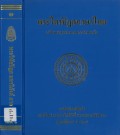
(1) พระไตรปิฎกภาษาไทย พระวินั…
พิมพ์เฉลิมพระเกียรติ สมเด็จพระนางเจ้าสิริกิติ์ พระบรมราชินีนาถ เนื่�…
- ครั้งที่จัดทำ
- 1
- ISBN/ISSN
- 9745753696
- ลักษณะวัสดุ
- -
- ชื่อชุด
- พระไตรปิฎกภาษาไทย ฉบับมหาจุฬาลงกรณราชวิทยาลัย
- เลขหมู่
- BQ 1173 T5 ม562 2539 ล.1
Seven Hundred Elegant Verses
When Go·várdhana composed his “Seven Hundred Elegant Verses” in Sanskrit in the twelfth century CE, the very title suggested to an educated Indian audience that this was a response to the 700…
- ครั้งที่จัดทำ
- -
- ISBN/ISSN
- 9780814736876
- ลักษณะวัสดุ
- 346 pp.
- ชื่อชุด
- Clay Sanskrit library, 55.
- เลขหมู่
- -

The Emperor of the Sorcerers (volume one) Cantos 1-17
Budha·svamin tells the astonishing epic tale of the youthful exploits of prince Nara·váhana·datta. It is indeed a great story, as its Sanskrit title declares. Epic in scope and scale, it has ev…
- ครั้งที่จัดทำ
- -
- ISBN/ISSN
- 9780814757017
- ลักษณะวัสดุ
- 2 volumes ; 17 cm.
- ชื่อชุด
- Clay Sanskrit library, 1.
- เลขหมู่
- PK 3794 .B84B713 2005 V.1
Málavika and Agni·mitra
While the other works of Kali·dasa are populated by supernatural beings and larger-than-life people, “Málavika and Agni·mitra” derives its plot from history and features thoroughly mortal ch…
- ครั้งที่จัดทำ
- -
- ISBN/ISSN
- 9780814787021
- ลักษณะวัสดุ
- 346 pp.
- ชื่อชุด
- Clay Sanskrit library, 56.
- เลขหมู่
- -
Maha·bhárata X-XI: Dead of Night & The Women.
Three exhausted warriors return to their camp, stunned to find it overrun by their enemies. Their fellow soldiers all lie dead. The sound of their enemies, the five sons of Pandu and their allies t…
- ครั้งที่จัดทำ
- -
- ISBN/ISSN
- 9780814717271
- ลักษณะวัสดุ
- 416 pp.
- ชื่อชุด
- Clay Sanskrit library, 54.
- เลขหมู่
- -
Maha·bhárata VII: Drona (volume two of four).
Volume Two of ‘Drona’ begins in the aftermath of tragedy. As evening falls, Árjuna journeys wearily back to camp and is greeted by the ashen faces of his brothers. Before they speak, he guesse…
- ครั้งที่จัดทำ
- -
- ISBN/ISSN
- 9780814767764
- ลักษณะวัสดุ
- 394 pp.
- ชื่อชุด
- Clay Sanskrit library, 53.
- เลขหมู่
- -
The Rise of Wisdom Moon
“The Rise of Wisdom Moon” (Prabodhacandrodaya) was composed during the mid-eleventh century by Krishna·mishra, an otherwise unknown poet in the service of the Chandella dynasty, whose cultural…
- ครั้งที่จัดทำ
- -
- ISBN/ISSN
- 9780814748381
- ลักษณะวัสดุ
- 396 pp.
- ชื่อชุด
- Clay Sanskrit library, 52.
- เลขหมู่
- -
Princess Kadámbari (volume one of three) Cantos 1-2
No Sanskrit poet is more interesting, original, or greater than Bana. His prose poem “Princess Kadámbari” is his supreme achievement. His patron, King Harsha, ruled much of northern India from…
- ครั้งที่จัดทำ
- -
- ISBN/ISSN
- 9780814740804
- ลักษณะวัสดุ
- 558 pp.
- ชื่อชุด
- Clay Sanskrit library, 51.
- เลขหมู่
- -
Garland of the Buddha’s Past Lives (volume two of two) Cantos 21-34
In this second volume of the “Garland of the Buddha’s Past Lives,” Arya·shura applies his elegant literary skill toward composing fourteen further stories that depict the Buddha’s quest fo…
- ครั้งที่จัดทำ
- -
- ISBN/ISSN
- 9780814795835
- ลักษณะวัสดุ
- 520 pp.
- ชื่อชุด
- Clay Sanskrit library, 50.
- เลขหมู่
- -
The Quartet of Causeries
“The Quartet of Causeries” date to the Gupta era, the time of Kali·dasa, but nothing certain is known about their four authors. Though stylistically divergent, they share a common plot: the he…
- ครั้งที่จัดทำ
- -
- ISBN/ISSN
- 9780814719787
- ลักษณะวัสดุ
- 508 pp.
- ชื่อชุด
- Clay Sanskrit library, 49.
- เลขหมู่
- -
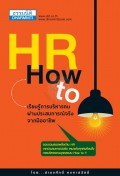

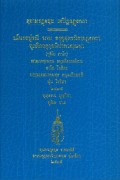
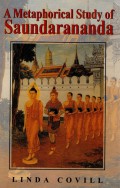
 Computer science, information & general works
Computer science, information & general works
 Philosophy & psychology
Philosophy & psychology
 Religion
Religion
 Social sciences
Social sciences
 Language
Language
 Pure Science
Pure Science
 Applied sciences
Applied sciences
 Arts & recreation
Arts & recreation
 Literature
Literature
 History & geography
History & geography